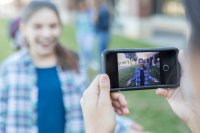Breaking the Ice With Student-Made Videos
用学生制作的视频打破僵局
Combining the six-word memoir with a film containing six shots gives students a way to introduce themselves at the beginning of the year.
将六个字的回忆录与一部包含六个镜头的电影结合起来,让学生们在年初介绍自己。
I came upon the work of Don Goble, a multimedia instructor from St. Louis, Missouri, and his Six-Word Story, Six Unique Shots project when I was struggling with how to begin a new year in a new way. Letters from students and poster board montages bored me. The feel of a glue stick gave me hives. Don’s project gave me pause. At that time, I had never made a film and my phone’s camera challenged me. However, I took a breath and ditched the traditional. The results amazed me.
当我正在努力以一种新的方式开始新的一年时,我偶然发现了来自密苏里州圣路易斯的多媒体教师唐·戈布尔的作品和他的六字故事,六个独特的镜头项目。学生们的来信和海报板上的蒙太奇让我厌烦,胶水棒的触感让我起了疹子。唐的计划让我犹豫了一下。那时我还没有拍过电影,手机的摄像头也对我提出了挑战。结果令我吃惊。
Six-Word Story, Six Unique Shots is a spin on the popular six-word memoir activity. Students begin by writing a six-word memoir, typically exploring their identity. They then create a 30-second film using only the six words of the memoir and six different types of film shots.
六字故事,六个独特的镜头是一个流行的六字回忆录活动旋转。学生开始写一个六字的回忆录,通常探索他们的身份。然后,他们只使用回忆录中的六个词和六种不同类型的电影镜头制作了一部30秒的电影。
The structure offers students an opportunity to deeply dive into their own interiority—or not. Students share stories of addiction, body image issues, and anxiety. They also create films hailing their love of coffee. The degree of vulnerability is truly up to the individual.
这种结构为学生提供了一个机会,让他们深入了解自己的专长。学生们分享成瘾,身体形象问题和焦虑的故事。他们还创作电影来海陵他们对咖啡的热爱。脆弱性的程度确实取决于个人。
You don’t need to be tech savvy or possess fancy equipment to pull off this project. All you really need is a desire to do something different. I’ll detail the schedule I use with a 90-minute block period.
你不需要精通技术或拥有花哨的设备来完成这个项目。你真正需要的是一种做不同事情的愿望。我将详细说明我使用的90分钟的时间段的时间表。
A Fun Bit of Self-Exploration
一个有趣的自我探索
Day 1: My students and I begin by analyzing Goble’s students’ examples. We discuss what an example tells us about the person. We talk about how an image communicates an idea and how a word supports an image and vice versa. Students begin drafting their memoir in class. They can complete their memoirs at home or in class, if you have the time.
第一天:我和我的学生开始分析戈布尔学生的例子。我们讨论一个例子告诉我们关于这个人的什么。我们讨论图像如何传达思想,以及单词如何支持图像,反之亦然。学生们开始在课堂上起草回忆录。如果你有时间,他们可以在家里或课堂上完成回忆录。
Day 2: We start this day by learning about the effects of different film shots. When is an extreme close-up most impactful? How does a low angle give the subject more power? Action movies work great for analyzing shot types because so much of the emotional intensity and audience engagement relies on the director’s choice of shots.
第2天:我们从学习不同电影镜头的效果开始这一天。什么时候一个极端的特写镜头最有影响力?低角度怎么能让目标给予更大的力量?动作片非常适合分析镜头类型,因为情感强度和观众参与度在很大程度上取决于导演对镜头的选择。
Day 3: Now is the time for students to storyboard their six-word memoirs into films. A storyboard is a series of small panels in which students sketch the look of a specific shot. It’s essentially a rough draft of their film; when completed it has the appearance of a comic book. Students begin to focus on both content and the logistics of the project. Are the shots different from one another? Where is the ideal filming location? Are any props or costumes needed?
第三天:现在是学生们把他们的六字回忆录改编成电影的时候了。故事板是一系列小面板,学生在其中勾勒出特定镜头的外观。这基本上是他们电影的草稿;完成后,它有一本漫画书的外观。学生开始关注项目的内容和后勤。这两个镜头是不是不一样?理想的拍摄地点在哪里?需要道具或服装吗?
Artistic talent is secondary here—stick figures are fine. What’s important is for students to align the purpose and weight of a word with the most effective shot. Considering the connection between word choice and meaning is something all developing writers can learn from doing.
艺术天赋在这里是第二位的--简笔画就可以了。对学生来说,重要的是要把一个词的目的和分量与最有效的镜头对准。考虑词语选择和意义之间的联系是所有发展中的作家都可以从中学习的。
Day 4: Today is the start of filming. Students may come in with fancy cameras, but most will probably use their phones. Before students begin filming, let them know that horizontal filming is a must. If they film vertically, the end result will be more difficult to edit, and it will look odd on screen. I use a fun tutorial to bring this message home; you should preview the video to ensure that it’s appropriate for your classroom.
第四天:今天是拍摄的开始。学生们可能会带着花哨的相机进来,但大多数人可能会使用手机。在学生开始拍摄之前,让他们知道水平拍摄是必须的。如果他们垂直拍摄,最终的结果将更难编辑,在屏幕上看起来会很奇怪。我用一个有趣的教程来传达这个信息;你应该预览视频,以确保它适合你的教室。
Day 5: Today students edit their films. There are essentially two options for editing hardware: the students’ phones or computers with editing software such as iMovie, Final Cut, or Adobe Premiere.
第五天:今天学生编辑他们的电影。编辑硬件基本上有两种选择:学生的手机或装有编辑软件(如iMovie、Final Cut或Adobe Premiere)的电脑。
Editing on the phone is the simplest way to get a great final product. Typically, iPhones come with a version of iMovie. Adobe Premiere Clip is a free editing app that works well with Android phones. With either program, the basic editing functions are easy to use.
在手机上编辑是获得优秀最终产品的最简单方法。通常,iPhone都带有一个版本的iMovie。Adobe Premiere Clip是一款免费的编辑应用程序,可以在Android手机上使用。无论使用哪种程序,基本的编辑功能都很容易使用。
Using computer software allows students many more advanced editing options, but I suggest keeping it simple. The Mac program iMovie is the easiest software to use and provides the basic editing options students will need. Final Cut Pro and Adobe Premiere Pro are considerably more advanced (and not free).
使用计算机软件可以让学生有更多的高级编辑选项,但我建议保持简单。Mac程序iMovie是最容易使用的软件,并提供学生需要的基本编辑选项。Final Cut Pro和Adobe Premiere Pro要先进得多(而且不是免费的)。
Often, the most challenging part of the editing process is getting the footage from the phone to the computer. If the students have a Google account, they can access their footage from any computer. Students have to download the footage before placing it into any editing software. Students can also use Apple’s Airdrop feature to transfer the footage, or a USB cable works well with both Apple and Android phones.
通常,编辑过程中最具挑战性的部分是将镜头从手机传输到电脑。如果学生们有一个谷歌帐户,他们可以从任何计算机访问他们的镜头。学生们必须先下载录像,然后再将其放入任何编辑软件。学生们还可以使用苹果的Airdrop功能来传输视频,或者USB电缆可以很好地与苹果和Android手机配合使用。
Once the film is complete, students share their final product with me by using Airdrop to send it to my computer, saving it to a hard drive, or sharing it with me via Google Drive. This allows me to review the work outside of class and to show each film on the big screen without needing to hook up each student’s individual phone or computer.
一旦电影完成,学生们通过使用Airdrop将其发送到我的电脑,将其保存到硬盘驱动器或通过Google Drive与我共享,与我分享他们的最终产品。这使我能够在课外复习作业,并在大屏幕上播放每部电影,而无需连接每个学生的个人手机或电脑。
Day 6: Film premiere! Bring the popcorn and get comfy.
第六天:电影首映!把爆米花拿来,舒服点。
Six days is a significant time investment, but consider the potential end product: engaged students with new skills, and a strong, safe class community.
六天是一个重要的时间投资,但考虑潜在的最终产品:从事新技能的学生,和一个强大的,安全的班级社区。

